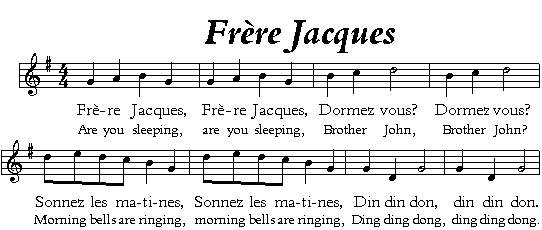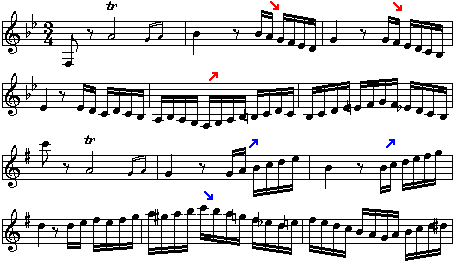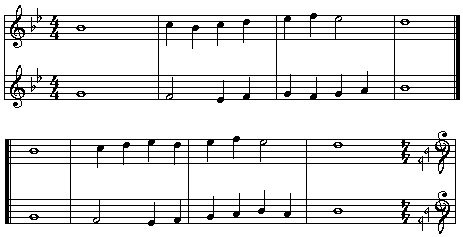
 |
|
|
Counterpoint is a technique for combining melodic lines
in a way that lets each remain independent. Rounds belong to a special kind of counterpoint called
canons. As with any kind of contrapuntal music, the voices in a
canon act independently, with the fun coming from hearing the interplay of
the different lines. And while some people can't stand Haydn or Wagner or Pink
Floyd, just about everyone likes the excitement of counterpoint.
The particular contrapuntal interplay in a canon is imitative. In the 'round' form of the canon (also called a circle canon), each voice exactly imitates the first voice, but delayed by however many measures make up each line. The earliest known canon, in fact, is a famous popular round from the late 13th century called Sumer Is I-Cumen In. Once people realized how nice an effect they could get from just having several voices imitating each other, it didn't take long to come up with several ways to vary the imitation, and several different types of canon evolved. Sometimes the imitation is a bit higher or lower in pitch. For example, the familiar "For Unto Us a Child is Born" from Handel's Messiah begins in a canon form. The tenors' entrance imitates the line the sopranos just finished (soundclip available). And had Handel kept going like this, he would have written a splendid round. When the altos enter, though, they come in on a lower note (soundclip), and then sing an exact imitation of the tenor line (the soundclip begins with the tenor line). Note that the altos imitate not only the tune but the rhythm of the tenor line. And when the basses come in, they start on the altos' note, but imitate exactly (both tune and rhythm) the sopranos' line. The result is the riotous interweaving of the lines that makes this piece an audience favorite (soundclip). The type of canon that uses pitch changes for its effects is often given a rather cryptic label, but once you know the system, it's fairly easy to decipher. To describe a canon as "four in one at the third" simply says that there are four voices singing one tune pitched an interval of a third apart. (According to this system, Frère Jacques would be described as a canon "three in one at the unison".) Canons can use other types of imitation: sometimes the second voice imitates the first, but halves or doubles the speed of the tune. Elaborate "Amens" at the end of some choral works often use this technique. (The technical terms for these are "augmentation" and "diminution".) Sometimes the second voice turns the tune upside down, which is called inversion. It's fairly easy to see what this is with a visual (and audio) example.  Beethoven's "Hammerklavier" sonata (Op.106) uses all sorts of contrapuntal devices in its last movement. If you look at just the theme (with the red arrows) and a bit abstracted from one of its variations (with the blue arrows), you'll see how the variation mirrors the original theme. (If you look too closely, you'll also see that Beethoven cheated a bit: it isn't a perfect mirror.) This is a very common contrapuntal device. In the Gloria from Henry Purcell's Evening Service, several fancy devices are being used. If you listen (soundclip) for the slower notes, you'll hear the inversion. In a rare form of imitation, the second voice repeats the melody backwards in what is called a "crab canon" (because it moves backwards). Most of these are more exercises than music. With the other types of canon, you can hear what's happening to the tune; a crab canon's tricks are meant for the eyes, not the ears. If you'd like to see and hear a crab canon in action, you can look at the center section of William Byrd's Diliges Dominum. It's not typical Byrd, which is usually more lively, but he's playing a rather complicated game with the music. A better known crab canon is the one in Bach's Musical Offering, which Douglas Hofstadter had a lot of fun with in Gödel, Escher, Bach. If you've read the book, you may want to listen to the music (a 34 second midi file). The trickiest of all canons is the inverted crab canon--this is music that reads the same way upside down, like this short tune by Mozart (sound file). 
|